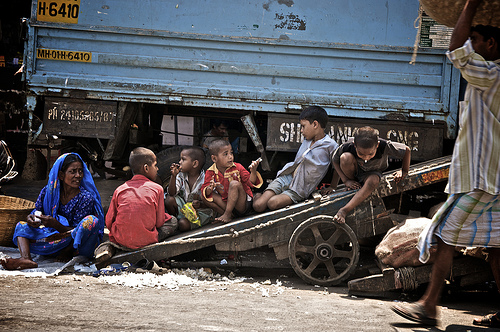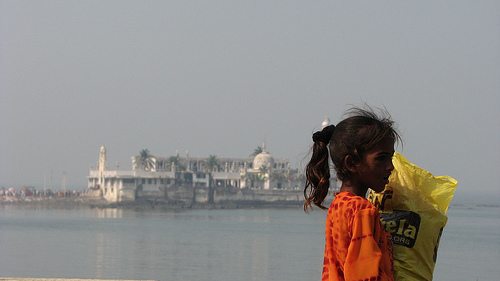Theme Essay by Lorraine Berry
Slumdog Millionaire vs. Behind the Beautiful Forevers
TW congratulates Katherine Boo for winning the 2012 National Book Award in nonfiction for Behind the Beautiful Forevers.
I blame the bad news I got about the dog. A weekend trip to the vet for some vaccinations had turned into one of those $400 nightmares. The vet called as I was watching Slumdog Millionaire—for the first, heart-racing time—to tell me the hound's bloodwork had come back "suspicious.” Unnerved, I returned to Slumdog and found myself with tears trickling down my face. Crying!
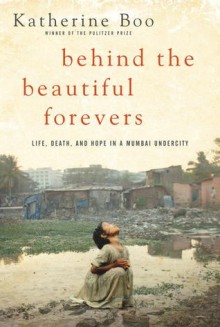 I felt especially upset because I’d recently read a devastating nonfiction book that was also, like Slumdog, about slum dwellers in India—Katherine Boo’s Behind the Beautiful Forevers: Life, Death, and Hope in a Mumbai Undercity. Despite my fervent admiration of Boo’s prose, I’d never once shed a tear.
I felt especially upset because I’d recently read a devastating nonfiction book that was also, like Slumdog, about slum dwellers in India—Katherine Boo’s Behind the Beautiful Forevers: Life, Death, and Hope in a Mumbai Undercity. Despite my fervent admiration of Boo’s prose, I’d never once shed a tear.
I'm a writer. What the hell was wrong with me? The dog news had made me susceptible, but I suspected the film tapped into my limbic system in ways that literary journalism cannot. I began to wonder if Boo's spectacular prose was precisely what had allowed me to read about the horror of the Mumbai slums without feeling it too viscerally.
Had Beautiful Forevers and Slumdog both manipulated me, just in different ways?
One was highly polished narrative journalism, the other a Hollywood-style movie. But which was more effective at conveying its truths to me—an American who has never traveled to India, half a world away—and why?
Behind the Beautiful Descriptions
Boo's book opens with young Abdul Hakim Husain:
Midnight was closing in, the one-legged woman was grievously burned, and the Mumbai police were coming for Abdul and his father. In a slum hut by the international airport, Abdul's parents came to a decision with an uncharacteristic economy of words.
The book focuses on several people who live and die within the Annawadi slum, a temporary settlement close to the airport and its “beautiful forever” tourist hotels in Mumbai (the former Bombay). But the crux of the story concerns what happens to the Husains. Their neighbors resent them for two reasons: They are Muslim in a mostly Hindu community, and the family has found a way to scrape together a better living than many. These resentments come to the fore when the Husains are accused of having driven their mentally disturbed next-door neighbor to set herself on fire, which eventually kills her.
The Husains resist the local slumlord's attempts to extort money from them in exchange for getting Abdul, his father, and his sister out of jail. Boo shows that while corruption can provide a way to greater power within the slums (as it does for the slumlord), it also works to keep people trapped within them. The Husains, who have been putting money away to buy a piece of land outside the slum, go broke during their prolonged encounter with the Indian judicial system.
On the surface, life in the slum is so grim that the idea of reading more than 250 pages about it might seem like an exercise in suffering. But Boo, a MacArthur recipient and New Yorker writer, makes this depiction much more than a condemnation of the slum's abysmal living conditions. She gives her characters such deeply felt, detailed lives that I genuinely came to care for them. As she notes in an interview on the book’s website:
[I]f a reader comes away from this book thinking of [these slum dwellers] only as pathetic socioeconomic specimens I'll have failed as a writer. They're cool, interesting kids, and I want the reader to sense that, too. Because we can talk all we want about how corruption or indifference robs people of opportunity….but if we don't really grasp the intelligences of those who are being denied, we're not going to grasp the potential that's being lost.
Boo's prose is luminous. She paints the sky above a police station at sunset as “clouds distended, the monsoon sky corded red.” She describes the lone boy who witnesses Abdul's attempts to go into hiding as "sitting, arms around his knees, in a spangly blue haze by the sewage lake—the reflected neon signage of a luxury hotel across the water."
She doesn’t romanticize the lives of those caught in the Mumbai undercity’s web of caste. There is closure to their stories, but no fake happy endings. In a world where days are spent sifting through trash for enough recyclable material to pay for meals, even the hardest-working, best-intentioned individuals can have their futures stolen by the workings of a corrupt system.
And, yet, Boo's poetic language also holds Western readers at a comfortable distance from the subject matter—a distance that kept me from bursting into tears each time something awful happened. Even though she witnessed some of the events she depicts and interviewed her subjects in depth, the scrim of journalism makes things feel less immediate. There is no "I" voice anywhere in this book, as there would have been with a memoir. Reading Behind the Beautiful Forevers, I admired it like a polished gem—and wondered what the original stone looked like.
On her website, Boo talks about how she wanted to capture the Mumbai she knew, which wasn’t the Mumbai she’d seen in other books and films:
For all the lush and brilliant depictions of wild festivals, megalomaniacal gangsters, and soulful prostitutes, I felt stinted of some everyday truths.... Over the years I’d find myself sighing as I read descriptions of the spicy Mumbai air—the cardamom and saffron that’s supposedly wafting everywhere. Sure, why not? But to me a signature smell of Mumbai is the same as that in many other developing cities. It’s the smell of sweat—of people hustling and maneuvering to find a niche in the global economy.
Boo reveals those desperate maneuvers in all their human complexity. But when it comes to smelling the sweat, the Mumbai of Slumdog Millionaire proves more effective in conjuring the feel of daily life in that city of fourteen million souls.
Buzz, Sweat, and Hustle
Here’s how director Danny Boyle describes Mumbai—which reminds him of 1970s New York City— in a 2008 New York magazine interview that came out around the same time as the film:
You go there, and it’s buzzing. The extremes you get are incredible! You cannot believe what you’re getting on film because you don’t go anywhere that’s boring. The city’s just exploding somehow. Destroying itself and re-creating itself at the same moment—the buzz you get off it!
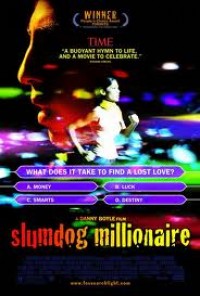 From the beginning, Boyle's vision of Mumbai is frenetic and colorful. Slumdog Millionaire is very loosely based on Vikas Swarup’s 2005 novel Q & A, but as I watched the film, I made constant comparisons with Boo’s book. In fact, I found myself identifying Abdul—Boo's protagonist—with the actor Dev Patel, who plays Jamal, one of Boyle's characters.
From the beginning, Boyle's vision of Mumbai is frenetic and colorful. Slumdog Millionaire is very loosely based on Vikas Swarup’s 2005 novel Q & A, but as I watched the film, I made constant comparisons with Boo’s book. In fact, I found myself identifying Abdul—Boo's protagonist—with the actor Dev Patel, who plays Jamal, one of Boyle's characters.
The movie starts with a similar premise, focusing on a family of Mumbai slum dwellers who are the targets of anti-Muslim resentment. Jamal and his brother Salim are orphaned when their mother is killed in front of them by a rioting Hindu mob. In a terrifying scene, their mother is struck down. The boys run, first to unresponsive police and finally to safety in an empty train car.
Do we get details of why the police don’t help them—and insights into a corrupt system—as we might with Boo? No. Instead, we’re plunged into the sensations of the boys’ terror. As I watched these two children, both under the age of ten, dash and dart through the crowds and the narrow streets, I felt myself panicking.
Boyle yanks viewers from extreme moment to extreme moment, as well as back and forth in time. The film opens not with the young brothers but with the adult Jamal being tortured in an Indian police station. He’s one question away from winning the big prize on a popular Indian television game show similar to Who Wants to Be a Millionaire?, and the police think he’s cheating.
How does a poorly educated "slumdog" know the answers to all the questions? Because, neatly enough, he has lived the answers to exactly the questions he’s asked, as viewers learn in a series of visceral, emotion-tugging flashbacks.
MEET THE BOYS! The boisterous brothers tumble into a scam of charging neighbors to use the communal pit toilets, but Jamal blows a sale by having shy bowels—just as a famous Bollywood actor is arriving at the nearby airport. Salim locks Jamal in the outhouse. In order to escape and meet his Bollywood hero (whose name will be the answer much later to one of the game show questions), Jamal jumps into the pit of excrement.
Covered with glistening ooze, he rushes to meet his hero through the crowd, soiling their colorful clothing with his filth. But Boyle also plays the scene for laughs. Jamal giggles with pure, little-kid innocence as he waves his prize: the actor's autograph. Yes, he’s a lovable scamp, and his brother is untrustworthy—and the movie hurtles on.
FLASHFORWARD! Jamal is no longer being tortured. Now he sits at a desk, exhausted. He tells his story to the chief, who listens and drinks chai.
FLASHBACK! The orphaned boys get by as trash pickers at the dump with their "third musketeer," a young girl named Latika who stirs Jamal’s feelings. A man who seems kindly rescues the three children and takes them home—to an “orphanage,” where he mutilates kids to make them more pitiful and successful as beggars.
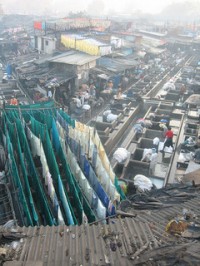
GUT PUNCH! A boy with a beautiful voice is laid on a table and chloroformed; a thug boils oil and pours it into a teaspoon. Salim, who witnesses the boy being blinded, retches into the dirt. The thug then tells Salim to bring Jamal next. It's obvious Jamal is about to be blinded, too.
But Salim saves his brother! Grabbing Latika, they run for a moving train. Latika almost makes it, but—in a heartbreaking moment of hands touching, then letting go—is left behind.
DANCE BEAT! The boys travel all over India, surviving by stealing food, selling knickknacks to passengers, sleeping on top of the moving train, and engaging in hijinks—all to a rocking beat.
BUMPY ROAD AHEAD! There’s the stunning beauty of the Taj, the colorful saris worn by women, the waving flags, the deep green of the countryside—until a new horror emerges—followed by a happy scene—followed by another horror.
UPSHOT! Boyle rubs my emotions raw. One moment, I want to cover my eyes in terror; the next, I'm loving the visuals and grooving to the exotic soundtrack.
By the time I get to the payoff—the unbelievably happy ending with Jamal declared innocent and winning great riches—and his dream girl Latika—I'm grinning through my tears. I'm thinking, “Well, life may be tough for those slumdog kids, but with hard work and a few lucky breaks, they can win in the end.”
Until I catch myself, and I'm pissed.
The Shock of Poverty
Having read Behind the Beautiful Forevers, I know it’s far more likely that Jamal would have been done in by the system that dragged down the Husains.
While Boo forces me to confront Mumbai's crushing poverty by describing its effects on real lives, Boyle bypasses my head altogether. He goes straight for my gut, gripping me with horrific moments and then luring me to the emotional payoff of a hope-filled ending. He even throws in a gratuitous dance scene at the end so that my last impression of the movie is of young bodies swirling to the beat of “Jai Ho.”
The writer in me—and the political activist troubled by romanticized poverty—wants Boo’s literary, nuanced journalism to trounce Boyle’s Hollywood/Bollywood portrayal of the Mumbai slums. My eldest daughter, who spent four months working in India and was deeply affected by the extremes of poverty she saw, said that Boo captures the truth of the India she witnessed.
Behind the Beautiful Forevers will stay with me. Boo made me see that the corruption in India is not all that different from that in our own country; it holds people in their place while offering them the constant mythology that escape is possible.
But on an emotional level? Slumdog Millionaire grabbed me harder, no contest. Boyle’s arsenal of filmmaker’s tools plunged me into the shock of poverty in Mumbai in a way that Boo’s careful prose could not. It's why I’m still so angry that he made me cry, damn it.
Not for long, though. And if anyone asks, I’ll swear it was really all about the dog.
Publishing Information
- Behind the Beautiful Forevers: Life, Death, and Hope in a Mumbai Undercity by Katherine Boo (Random House, 2012).
- “A Q & A With Katherine Boo and Her Editor, Kate Medina” on the Behind the Beautiful Forevers website.
- “Slumdog’s Underdog” by Logan Hill, New York, November 9, 2008.
- Excerpt from Q & A, the novel by Vikas Swarup that inspired Slumdog Millionaire; from the author’s website.
Art Information
- “Mumbai Street Scene” © Peter Rivera; Creative Commons license
- "Matunga, Mumbai" © Paul Morrison; Creative Commons license
- "Opposite Haji Ali Masjid, Mumbai" © Satbir Singh; Creative Commons license
 Lorraine Berry is an associate editor at Talking Writing. She teaches creative nonfiction at a college in the Finger Lakes region of New York.
Lorraine Berry is an associate editor at Talking Writing. She teaches creative nonfiction at a college in the Finger Lakes region of New York.Lorraine reassures us that her dog is fine. As it turns out, she's just fat. Lorraine and her partner Rob have added another mile to the daily dog walks and cut down on treats—and are still embarrassed about having such a First World problem.
“We’ve become a nation that relies on sound bites and memes to draw conclusions about issues that require rigorous analysis. But at least I know that each semester I release into the campus community a couple dozen students who have learned how to read between the lines.” — “What Students Need: a BS Detector”

